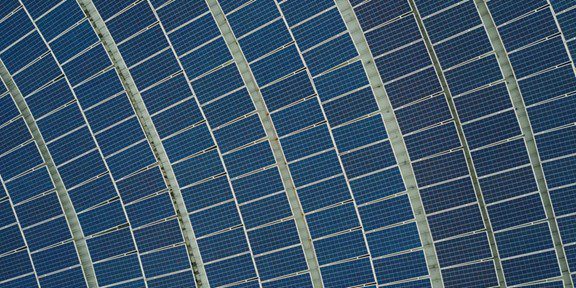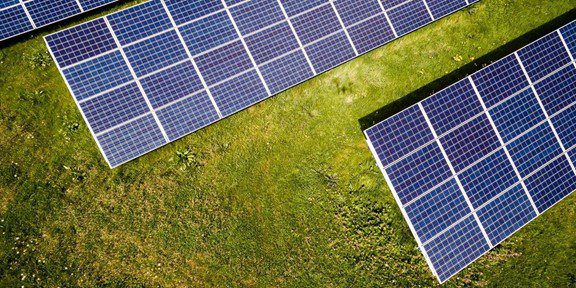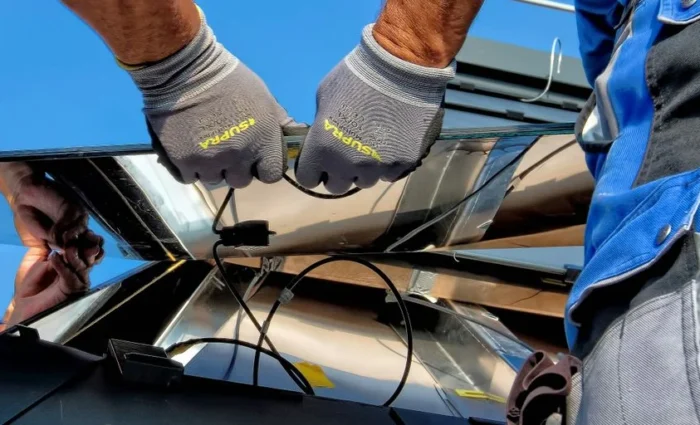Solar energy’s on the rise, and with that comes the need for efficient maintenance solutions. Enter fiberglass gratings. These are becoming the go-to choice for solar walkways. Why? They’re tough, light, and don’t rust. Plus, they keep workers safe from electric shocks. Let’s dive into why fiberglass gratings are making waves in solar projects.
Key Takeaways
• Fiberglass gratings are lightweight but strong, ideal for solar walkways.
• They resist corrosion, making them perfect for harsh weather conditions.
• Non-conductive properties ensure worker safety around electrical installations.
• Easy to install, saving time and labor costs during solar project setups.
• Low maintenance needs lead to long-term cost savings.
Understanding Fiberglass Gratings
Fiberglass gratings are a fantastic option for solar project walkways. Made from a mix of fiberglass and resin, these gratings are incredibly strong yet lightweight. They’re often used in places where metal might corrode, like in chemical plants or near the ocean. One of the best things about fiberglass gratings is how they stand up to the elements. They don’t rust or weaken in harsh weather, which is perfect for outdoor solar installations.
Importance of Solar Walkways
Solar walkways aren’t just paths; they’re essential for maintaining solar panels. They let workers move around safely and efficiently, which means they can keep the panels clean and working at their best. Without proper walkways, maintenance would be tricky and potentially dangerous. Plus, well-designed walkways can even help prevent damage to the panels themselves.
Integration of Fiberglass in Solar Projects
Integrating fiberglass gratings into solar projects is a smart move. They’re easy to install and don’t need a lot of upkeep, saving time and money in the long run. These gratings are also non-conductive, which adds an extra layer of safety for workers. And because they’re customizable in terms of size and shape, they can fit any project need. This makes them an ideal choice for solar walkways, providing a reliable and durable solution.
Advantages of Using Fiberglass Gratings for Solar Walkways
When it comes to solar walkways, one of the standout features of fiberglass gratings is their incredible resistance to corrosion. Solar installations are often exposed to harsh weather conditions—think rain, sun, and wind. Traditional materials like metal can rust over time, but fiberglass stays strong and intact. This makes it a perfect fit for areas where the elements are unpredictable and harsh. With fiberglass, you avoid the structural issues and safety hazards that come with corrosion, keeping maintenance to a minimum.
Lightweight and Durable
Fiberglass gratings are not just tough; they’re also lightweight. This combination makes them easy to handle and install, which is a big deal in solar projects. You don’t need heavy machinery or a large crew to get them in place. Plus, their durability means they can withstand a lot of wear and tear without needing frequent replacements. This durability, paired with their lightweight nature, reduces the load on structures, making them ideal for rooftop solar installations.
Non-Conductive Properties
Another key advantage is that fiberglass gratings are non-conductive. In environments where electricity is being generated, like solar farms, this is crucial. You don’t want the risk of electric shocks lingering over maintenance crews or anyone else walking on these pathways. Fiberglass provides a safe, non-conductive surface, minimizing the risk of electrical accidents. This is especially important in wet conditions where the risk of electric shock could be higher with conductive materials.
Installation Process of Fiberglass Gratings in Solar Projects
Installing fiberglass gratings for solar projects might sound like a daunting task, but it’s pretty straightforward. Here’s a simple guide to get you started:
- Preparation: Before you begin, make sure you have all the necessary materials and tools. This includes the fiberglass gratings, measuring tape, cutting tools, and fastening systems.
- Measurement and Cutting: Measure the area where the gratings will be installed. Cut the gratings to fit the specific dimensions using a saw or cutting tool suitable for fiberglass.
- Placement: Position the gratings over the designated area. Ensure they’re aligned properly for a snug fit.
- Securing: Use clamps or fasteners to secure the gratings in place. Make sure they are tightly fastened to prevent any movement.
- Final Checks: Once installed, walk over the gratings to check for stability. Ensure there are no loose parts or uneven surfaces.
Tools and Materials Required
- Fiberglass gratings: The primary material for creating durable and safe walkways.
- Measuring tape: Essential for accurate measurements to ensure proper fitting.
- Cutting tools (e.g., saw): Used to cut the gratings to the required size and shape.
- Fastening systems (e.g., clamps, screws): Necessary for securing the gratings in place.
- Safety gear (gloves, goggles): Protects workers during installation and cutting processes.
Common Installation Challenges
- Cutting Precision: Fiberglass can be tough to cut precisely. Always double-check measurements before cutting to avoid wastage.
- Alignment Issues: Misalignment can lead to uneven surfaces. Take your time to ensure gratings are perfectly aligned.
- Weather Conditions: Installations in harsh weather can be tricky. Plan your installation on a day with favorable weather conditions.
Installing fiberglass gratings in solar projects is about ensuring safety and functionality. It’s not just about laying down panels; it’s about creating a safe, durable path for maintenance and operations. With the right tools and a bit of patience, you can achieve a seamless installation.
For more innovative options in designing light and space, consider self-luminous and translucent GRP gratings from MM srl, which offer architects and designers creative solutions.
Safety Features of Fiberglass Gratings in Solar Walkways
Fiberglass gratings are known for their slip-resistant surfaces, which are crucial in maintaining worker safety on solar walkways. The textured surface provides excellent grip, reducing the risk of slips and falls even in wet or icy conditions. This feature is particularly important in areas where weather conditions can be unpredictable. The slip-resistant nature of fiberglass gratings makes them an ideal choice for solar projects, ensuring that maintenance crews can move safely without the fear of accidents.
When it comes to safety in solar projects, fiberglass gratings provide a reliable solution that combines slip resistance, fire retardancy, and weather resilience, making them a top choice for sustainable and secure solar walkways.
Fire Retardant Properties
Safety in solar installations isn’t just about preventing falls; it’s also about minimizing fire risks. Fiberglass gratings are designed with fire retardant properties that help prevent the spread of flames. This characteristic is vital in solar projects where electrical components and wiring are present. By choosing fire retardant materials, project managers can significantly reduce the potential for fire hazards, ensuring a safer environment for both workers and the installation itself.
UV and Weather Resistance
Solar projects are often exposed to harsh environmental conditions, including intense sunlight and extreme weather. Fiberglass gratings are built to withstand these elements, offering UV resistance that prevents degradation over time. This durability ensures that the walkways remain safe and functional for years, even under constant exposure to the sun’s rays. The weather-resistant properties of fiberglass gratings also mean they won’t warp, crack, or become brittle in extreme temperatures, maintaining their structural integrity throughout their lifespan.
Cost-Effectiveness of Fiberglass Gratings for Solar Walkways

When it comes to outfitting solar projects with walkways, initial costs can be a big concern. Fiberglass gratings, however, offer a compelling balance between upfront investment and long-term savings. Unlike traditional materials like metal or wood, fiberglass is designed to withstand harsh environmental conditions, which means less frequent replacements. While the initial purchase price might be higher than some alternatives, the reduced need for repairs and replacements over time can lead to significant savings.
Initial Investment vs. Long-Term Savings
Fiberglass gratings are a cost-effective solution for solar walkways. Although the initial investment may be higher compared to traditional materials, the long-term savings are substantial. Their durability and resistance to corrosion mean fewer replacements and repairs, reducing overall project costs over time.
Maintenance Cost Reduction
One of the standout features of fiberglass gratings is their low maintenance requirements. These materials are resistant to corrosion, which is a common issue in outdoor solar installations. This resistance not only extends the life of the walkways but also reduces the need for costly maintenance procedures. Routine cleaning with a simple rinse is often sufficient to keep them in good condition, unlike metal walkways that may require regular painting or rust treatment.
Comparing with Traditional Materials
When comparing fiberglass gratings to traditional materials, several factors come into play:
- Durability: Fiberglass is less prone to wear and tear, making it a long-lasting choice.
- Weight: Being lightweight, it reduces transportation and installation costs.
- Safety: Its non-conductive properties make it safer around electrical installations, unlike metal.
Overall, fiberglass gratings provide a cost-effective solution for solar projects by offering durability, reduced maintenance, and enhanced safety. As solar technology continues to advance, the integration of materials like fiberglass in FRP solar walkways is becoming an economically viable option, ensuring that these installations remain efficient and safe.
Customization Options for Fiberglass Gratings in Solar Projects

Fiberglass gratings bring a level of customization that is hard to match, providing both aesthetic and practical solutions in solar project walkways. Whether it’s about matching a project’s branding or meeting stringent safety criteria, these gratings can be tailored to fit the bill perfectly.
Color and Design Variability
When it comes to customization options for solar accessories, fiberglass gratings offer a broad palette of colors and designs. This flexibility ensures that the walkways can blend seamlessly with the surrounding environment or stand out as a design feature. You can choose from standard colors like yellow, green, or gray, but there’s also the option for custom hues to match specific project aesthetics.
Size and Shape Customization
Fiberglass gratings are not just about looks; they can be cut and molded into various sizes and shapes to fit the specific layout of a solar installation. Whether you need a narrow path or a wide platform, these gratings can be adjusted to meet the exact dimensions required. This adaptability makes them ideal for projects with unique spatial constraints or irregular layouts.
Tailoring to Specific Project Needs
Every solar project is different, and fiberglass gratings can be customized to meet specific functional requirements. This includes adjusting the load-bearing capacity, slip resistance, and even the surface texture to suit particular safety standards or environmental conditions. With these options, project managers can ensure that the walkways not only fit physically but also function optimally in their intended use.
Environmental Impact of Fiberglass Gratings in Solar Walkways
Choosing fiberglass gratings for solar walkways is not just a smart economic decision but also a responsible environmental choice. It aligns with global efforts to create more sustainable and eco-friendly infrastructure.
Sustainability and Eco-Friendliness
Fiberglass gratings are a sustainable choice for solar walkways. They are made from materials that are not only durable but also eco-friendly. Unlike traditional materials like metal, fiberglass doesn’t corrode, which means it doesn’t release harmful substances into the environment. This makes it a great choice for projects focused on sustainability.
Reducing Carbon Footprint
By opting for fiberglass gratings, solar projects can significantly cut down their carbon emissions. The production process of fiberglass is less energy-intensive compared to metals, which helps in minimizing carbon output. Additionally, since FRP walkways offer customizable grating designs that enhance water drainage, they prevent water accumulation around solar panels, which can reduce maintenance and energy costs, further lowering the carbon footprint.
Recyclability of Materials
One of the standout features of fiberglass gratings is their recyclability. At the end of their life cycle, these gratings can be recycled, ensuring that they do not end up in landfills. This aspect of recyclability not only supports environmental conservation but also promotes a circular economy where materials are reused rather than discarded.
Case Studies of Fiberglass Gratings in Solar Walkways
Fiberglass gratings have been making waves in solar projects globally. One standout example is a federal building in Portland, Oregon, where FRP gratings were installed as rooftop walkways between solar panels. The choice of Corvex® square mesh molded grating was key due to its corrosion resistance and non-conductive properties. This project demonstrated the efficiency of fiberglass gratings in providing safe and durable access paths for maintenance workers.
Successful Implementations Worldwide
Another success story comes from a solar farm in Spain, where fiberglass gratings were used extensively. The gratings’ lightweight nature allowed for quick installation across vast areas, minimizing labor costs and downtime. Their non-slip surface ensured worker safety during routine maintenance, a crucial factor in the project’s success.
Lessons Learned from Past Projects
From these implementations, several lessons have emerged:
- Material Selection Matters: Choosing the right type of fiberglass grating can significantly impact the project’s longevity and safety.
- Installation Efficiency: Projects that prioritize easy-to-install materials see reduced labor costs and faster completion times.
- Environmental Considerations: Understanding the local environment helps in selecting materials that can withstand specific weather conditions, ensuring long-term performance.
Future Trends in Solar Walkway Design
Looking ahead, the integration of smart technology with fiberglass gratings is an emerging trend. Imagine walkways equipped with sensors to monitor panel performance or detect maintenance needs. This innovation could revolutionize how solar farms operate, making them more efficient and responsive.
Future Innovations in Fiberglass Gratings for Solar Walkways

The world of solar walkways is changing fast, and fiberglass gratings are at the heart of it. New materials and tech are making these walkways even better. Imagine gratings that not only support your weight but also capture solar energy. That’s right, embedded solar panels on the walkway can now generate electricity, providing power for walkway lighting and connected devices. This innovation doesn’t just cut down on energy costs but also supports environmental sustainability.
Potential for Smart Walkways
Smart walkways are the next big thing. Picture walkways that can communicate with you. These paths could have sensors that detect motion, temperature, and even air quality. They could alert maintenance teams when repairs are needed or adjust lighting based on foot traffic. The integration of the Internet of Things (IoT) into fiberglass gratings could transform how we interact with these pathways.
Integration with Renewable Energy Systems
Integrating with renewable energy systems is a game-changer for fiberglass gratings. These walkways can now be part of a larger network that includes solar panels, wind turbines, and battery storage systems. By being part of a complete renewable setup, these gratings help in reducing the carbon footprint and promoting a sustainable environment.
Wrapping It Up: The Case for Fiberglass Gratings in Solar Projects
So, there you have it. Fiberglass gratings are really making a splash in the solar world. They’re not just about being tough and lasting long, though that’s a big part of it. It’s also about safety and ease of use. These walkways are non-conductive, which is a big deal when you’re working around electricity. Plus, they’re lightweight and easy to install, saving time and effort. And let’s not forget the slip-resistant surface, which is a huge plus for worker safety. All these perks make fiberglass gratings a smart choice for solar projects. They keep things running smoothly and safely, which is what you want when you’re dealing with solar panels. So, if you’re in the solar game, it’s worth considering fiberglass gratings for your next project.


